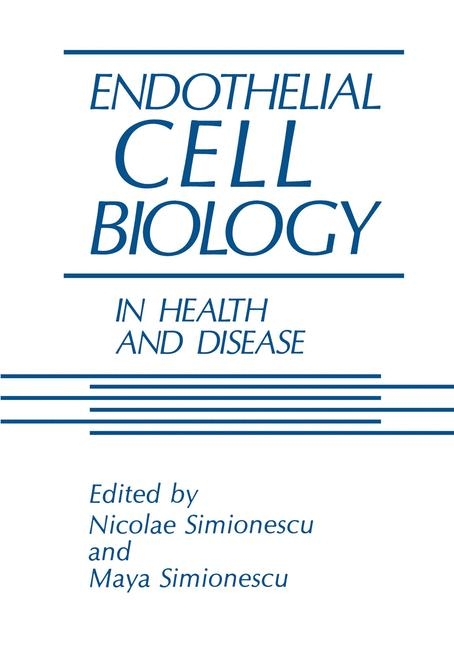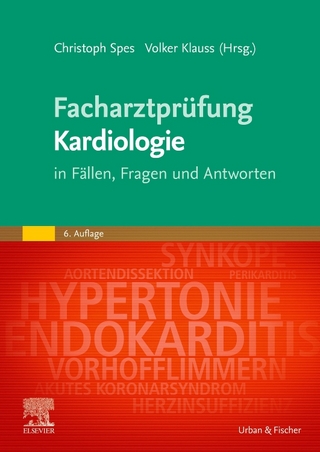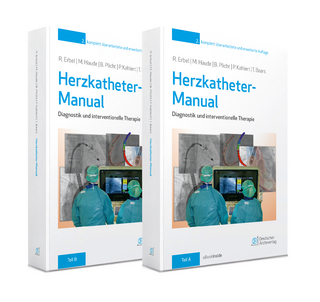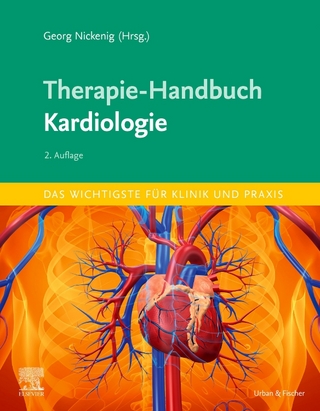
Endothelial Cell Biology in Health and Disease
Kluwer Academic/Plenum Publishers (Verlag)
978-0-306-42751-0 (ISBN)
- Titel ist leider vergriffen;
keine Neuauflage - Artikel merken
I. Structure-Function Correlations in Endothelial Cells.- 1. The Microvascular Endothelium Revisited.- I. Well-Established Knowledge.- II. New Information.- III. Controversies.- IV. New Developments.- V. Concluding Remarks.- References.- 2. Ultrastructural Studies of Capillary Endothelium: Compartmental Tracing, High-Voltage Electron Microscopy, afid Cryofixation.- I. Introduction.- II. Three-Dimensional Analysis of the Capillary Wall.- III. Fixation of Capillary Endothelium for Electron Microscopy.- IV. Structure-Function Relationships in the Capillary Wall.- V. Concluding Remarks.- References.- II. Transport Functions of Endothelial Cells.- 3. Transport Pathways and Processes.- I. Introduction.- II. The “Pore” Theory of Capillary Permeability.- III. Morphologically Identified Transport Pathways.- IV. A Pathophysiological Transport Pathway.- V. Relation of Endothelial Structure to Its Transport Function.- VI. Concluding Remarks.- References.- 4. Receptor-Mediated Trariscytosis of Plasma Molecules by Vascular Endothelium.- I. Introduction.- II. Endothelial Cell Regulation of Vascular Permeability.- III. Molecular Interactions at Plasma-Endothelial Interface.- IV. Sorting of Molecules: Endocytosis and Transcytosis.- V. Receptor-Mediated Transcytosis.- VI. Endothelial Cells of Continuous Capillaries Express Albumin Binding Proteins.- Receptor-Mediated Transcytosis Is a Basic Process Shared by Most Epithelia.- Concluding Remarks.- References.- 5. Studies of Pulmonary Endothelial Permeability Using Tritiated Dextrans.- I. Introduction.- II. Experimental Methods.- III. Results.- IV. Discussion.- V. Concluding Remarks.- References.- III. Endothelial Cell Growth and Differentiation.- 6. Endothelial Morphogenesis.- I. Developmental Biology of the Endothelium.- II. Endothelial Replication in Vivo.- III. Inhibition of Endothelial Replication by Cell-Cell Interaction.- IV. Cell-Cell and Cell-Substrate Adhesion Molecules.- V. Morphogenic Control of Growth: A Hypothesis.- References.- IV. Endothelial Cytoskeleton and Matrix and Their Interactions.- 7. The Endothelial Junction: The Plaque and Its Components.- I. Introduction.- II. Electron Microscopy of Endothelial Junctions.- III. Characterization of Junctions by Marker Proteins.- IV. Immunolocalization of Cytoskeletal Proteins in Endothelial Cells.- V. Structure-Bound and Soluble Forms of Junction Plaque Proteins.- VI. The Endothelial Junction as a Zonula Adhaerens: Conclusions and Perspectives.- References.- 8. Endothelial Cell-Extracellular Matrix Interactions: Matrix as a Modulator of Cell Function.- I. Introduction.- II. Endothelial Cell-Subendothelial Matrix Interactions: In Vivo Considerations.- III.Endothelial Cell-Extracellular Matrix Interactions: In Vitro Considerations.- IV. Concluding Remarks.- References.- V. Endothelial Cell Anticoagulant and Fibrinolytic Activities.- 9. Assembly and Function of the Protein C Anticoagulant Pathway on Endothelium.- I. Introduction.- II. Protein C-Structural Domains.- III. Expression of Protein C-Anticoagulant Activity.- IV. Discovery of TM.- V. Comparison of Purified TM with the Endothelial Cell Surface.- VI. Influence of TM on Thrombin Specificity.- VII. Variation of TM Properties between Cell Lines.- VIII. Expression of Activated Protein C Anticoagulant Activity.- IX. Regulation of Endothelial Cell TM Activity during Inflammatory Responses.- X. Review of the Protein C System in Thrombotic Disease.- XI. Perspectives.- XII. Concluding Remarks.- References.- 10. The Biochemistry and Physiology of Anticoagulantly Active Heparinlike Molecules.- I. Introduction.- II. Heparin-Antithrombin Interaction.- III. Structure-Function Relationship between Heparin and Antithrombin.- IV. Vascular Tissue Heparan Sulfate.- V. Heparan Sulfate Proteoglycans from Endothelial Cells.- VI. Physiological Role of Proteoheparan Sulfate.- References.- 11. The Fibrinolytic System of Cultured Endothelial Cells.- I. Introduction.- II. Fibrinolytic System of Cultured Endothelial Cells.- III. Discussion.- References.- VI. Endothelial Cell Procoagulant Activity.- 12. Vascular Endothelium: Functional Modulation at the Blood Interface.- I. Introduction.- II. Experimental Procedures.- III. Results and Discussion.- IV. Perspectives.- V. Concluding Remarks.- References.- 13. Endothelium and the Regulation of Coagulation.- I. Introduction.- II. A Procoagulant Pathway on the Endothelial Cell Surface.- III.Consequences of the Generation of Procoagulant Enzymes in Close Proximity to the Endothelial Cell Surface.- IV. Integration of the Endothelial Cell Procoagulant Pathway and Anticoagulant Mechanisms.- V. Concluding Remarks.- References.- VII. Endothelial Cell Response to Stress Factors.- 14. Heat-Shock Response as a Possible Model for (Patho)physiological Stress in Endothelial Cells.- I. Introduction.- II. Materials and Methods.- III. Results and Discussion.- IV. Perspectives.- References.- 15. Endothelial Activation: Its Role in Inflammatory and Immune Reactions.- I. Actions of Specific Cytokines on Endothelial Cells in Culture.- II. . Endothelial Activation in Vivo.- References.- 16. Intimal Responses to Shear Stress, Hypercholesterolemia, and Hypertension: Studies in the Rat Aorta.- I. . The Rat Aorta as an Experimental System.- II. Intimal Changes Related to Flow Disturbances: Effects of Acute and Chronic Stenosis.- III. Intimal Changes in Hypercholesterolemia: The “Inflammatory Theory” of Atherosclerosis.- IV. Shear Stress and Lipid Deposition: A Study Based on Aortic Stenosis.- V. Intimal Changes in Hypertension.- VI. Perspectives.- References.- VIII. Endothelial Cell in Atherogenesis.- 17. Endothelial Injury and Atherosclerosis.- I. Introduction.- II. Response to Injury Hypothesis of Atherosclerosis.- III. Cellular Interactions during Hypercholesterolemia.- IV. Blood Cells, Arterial Cells, and Growth Factor Formation.- V. Concluding Remarks.- References.- 18. Prelesional Changes of Arterial Endothelium in Hyperlipoproteinemic Atherogenesis.- I. Introduction.- II. Modeling of Experimental Hypercholesterolemia.- III. Lesional Stages Considered.- IV. Transport of Lipoproteins by the Normal Artery Wall.- V. Transport and Accumulation of (3-VLDL in the Artery Wall of Hypercholesterolemic Rabbits.- VI. Extracellular Accumulation of Lipoprotein-Derived Components.- VII. Changes in the Surface Charge and Chemistry of Arterial Endothelium and Monocytes.- VIII. Endothelial Modifications in the Early Stages of Atherogenesis.- IX. Concluding Remarks.- References.- 19. Response of Blood Vessel Cells to Viral Infection.- I. Introduction.- II. Experimental Procedures.- III. Results.- IV. Discussion.- References.
| Erscheint lt. Verlag | 30.6.1988 |
|---|---|
| Zusatzinfo | 103 Illustrations, black and white; XX, 478 p. 103 illus. |
| Verlagsort | New York |
| Sprache | englisch |
| Gewicht | 960 g |
| Themenwelt | Medizinische Fachgebiete ► Innere Medizin ► Kardiologie / Angiologie |
| Naturwissenschaften ► Biologie ► Mikrobiologie / Immunologie | |
| Naturwissenschaften ► Biologie ► Zellbiologie | |
| ISBN-10 | 0-306-42751-6 / 0306427516 |
| ISBN-13 | 978-0-306-42751-0 / 9780306427510 |
| Zustand | Neuware |
| Informationen gemäß Produktsicherheitsverordnung (GPSR) | |
| Haben Sie eine Frage zum Produkt? |
aus dem Bereich


